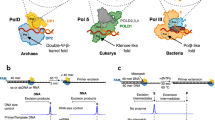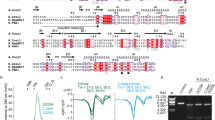Abstract
Exonuclease I (ExoI) from Escherichia coli is a monomeric enzyme that processively degrades single stranded DNA in the 3′ to 5′ direction and has been implicated in DNA recombination and repair. Determination of the structure of ExoI to 2.4 Å resolution using X-ray crystallography verifies the expected correspondence between a region of ExoI and the exonuclease (or proofreading) domains of the DNA polymerases. The overall fold of ExoI also includes two other regions, one of which extends the exonuclease domain and another that can be described as an elaborated SH3 domain. These three regions combine to form a molecule that is shaped like the letter C, although it also contains a segment that effectively converts the C into an O-like shape. The structure of ExoI thus provides additional support for the idea that DNA metabolizing enzymes achieve processivity by completely enclosing the DNA.
This is a preview of subscription content, access via your institution
Access options
Subscribe to this journal
Receive 12 print issues and online access
$209.00 per year
only $17.42 per issue
Buy this article
- Purchase on SpringerLink
- Instant access to full article PDF
Prices may be subject to local taxes which are calculated during checkout




Similar content being viewed by others
Accession codes
References
Kuzminov, A. In Recombinational repair of DNA damage (R.G. Landes Co., Austin; 1996).
Kushner, S., Nagaishi, H., Templin, A. & Clark, A.J. Proc. Natl. Acad. Sci. USA 68, 824– 827 (1971).
Razavy, H., Szigety, S.K. & Rosenberg, S.M. Genetics 142, 333– 339 (1996).
Feng, W-Y. & Hays, J.B. Genetics 140, 1175–1186 (1995).
Sandigursky, M. & Franklin, W.A. Nucleic Acids Res. 20, 4699–4703 ( 1992).
Bzymek, M., Saveson, C.J., Feschenko, V.V. & Lovett, S.T. J. Bacteriol. 181, 477–482 (1999).
Viswanathan, M. & Lovett, S. Genetics 149, 7–16 (1998).
Koonin, E. Curr. Biol. 7, R604–R606 (1997).
Moser, M.J., Holley, W.R., Chatterjee, A. & Mian, I.S. Nucleic Acids. Res. 25, 5110–5118 (1997).
Bernad, A., Blanco, L., Lazaro, J.M., Martin, G. & Salas, M. Cell 59, 219 –228 (1989).
Lehman, I. & Nussbaum, A. J. Biol. Chem. 239, 2628–2636 (1964).
Lehman, I. J. Biol. Chem. 235, 1479–1487 (1960).
Thomas, K. & Olivera, B. J. Biol. Chem. 253, 424–429 (1978).
Brody, R.S., Doherty, K.G. & Zimmerman, P.D. J. Biol. Chem. 261, 7136– 7143 (1986).
Brody, R.S. Biochemistry 30, 7072–7080 (1991).
Krishna, T.S.R., Kong, X-P., Gary, S., Burgers, P.M. & Kuriyan, J. Cell 79 , 1233–1243 (1994).
Kovall, R. & Matthews, B.W. Science 277, 1824–1827 (1997).
Hingorani, M. & O'Donnell, M. Curr. Biol. 8, R83–R86 (1998).
Prasher, D.C., Conarro, L. & Kushner, S.R. J. Biol. Chem. 258, 6340–6343 (1983).
Holm, L. & Sander, C. J. Mol. Biol. 233, 123–138 (1993).
Musacchio, A., Wilmanns, M. & Saraste, M. Prog. Biophys. Molec. Biol. 61, 283–297 (1994).
Brautigam, C.A., Sun, S., Piccirili, J.A. & Steitz, T.A. Biochemistry 38, 696–704 (1999).
Beese, L.S. & Steitz, T.A. EMBO J. 10, 25–33 (1991).
Derbyshire, V., Pinsonneault, J.K. & Joyce, C.M. Methods Enzymol. 262 , 363–385 (1995).
Brody, R.S. & Doherty, K.G. Biochemistry 24, 2072–2076 (1985).
Ceska, T.A., Sayers, J.R., Stier, G. & Suck, D. Nature 382, 90–93 (1996).
Divne, C., Stahlberg, J., Teeri, T.T. & Jones, T.A. J. Mol. Biol. 275, 309–325 (1998).
Parsiegla, G. et al. EMBO J. 17, 5551–5562 (1998).
Gassner, N.C., Baase, W.A., Hausrath, A.C. & Matthews, B.W. J. Mol. Biol. 294, 17–20 (1999).
Otwinowski, Z. & Minor, W. Methods Enzymol. 276, 307–326 ( 1997).
Collaborative Computational Project, Number 4. Acta Crystallogr. D 50, 760–763 (1994).
de La Fortelle, E. & Bricogne, G. Methods Enzymol. 276, 472–494 ( 1997).
Jones, T.A., Zou, J.Y., Cowan, S.W. & Kjelgaard, M. Acta Crystallogr. A 47, 110–119 ( 1991).
Tronrud, D.E. Methods Enzymol. 277, 306–319 (1997).
Brunger, A.T. et al. Acta Crystallogr. D 54, 905– 921 (1998).
Carson, M. Methods Enzymol. 277, 493–505 (1997).
Nicholls, A., Sharp, K.A. & Honig, B. Proteins 11, 282 ( 1991).
Acknowledgements
We thank L. Gay for providing the DH5α genome and for excellent technical assistance, R. Kovall for assistance and critical reading of the manuscript, I. Korndoerfer and M. Elsliger for help with computing aspects, P. Kuhn and A. Cohen for help with data collection at the SSRL and R. Kingston for critical reading of the manuscript. This work was supported in part by an NIH grant (to B.W.M.) and is based in part upon data collected at SSRL which is funded by the DOE and the NIH.
Author information
Authors and Affiliations
Corresponding author
Rights and permissions
About this article
Cite this article
Breyer, W., Matthews, B. Structure of Escherichia coli exonuclease I suggests how processivity is achieved. Nat Struct Mol Biol 7, 1125–1128 (2000). https://doi.org/10.1038/81978
Received:
Accepted:
Issue Date:
DOI: https://doi.org/10.1038/81978
This article is cited by
-
Near-complete depolymerization of polyesters with nano-dispersed enzymes
Nature (2021)
-
Construction of an aerolysin nanopore in a lipid bilayer for single-oligonucleotide analysis
Nature Protocols (2017)
-
Single-molecule analysis of DNA-protein complexes using nanopores
Nature Methods (2007)
-
Structural insight into poly(A) binding and catalytic mechanism of human PARN
The EMBO Journal (2005)
-
X‐ray structure and activity of the yeast Pop2 protein: a nuclease subunit of the mRNA deadenylase complex
EMBO reports (2003)



